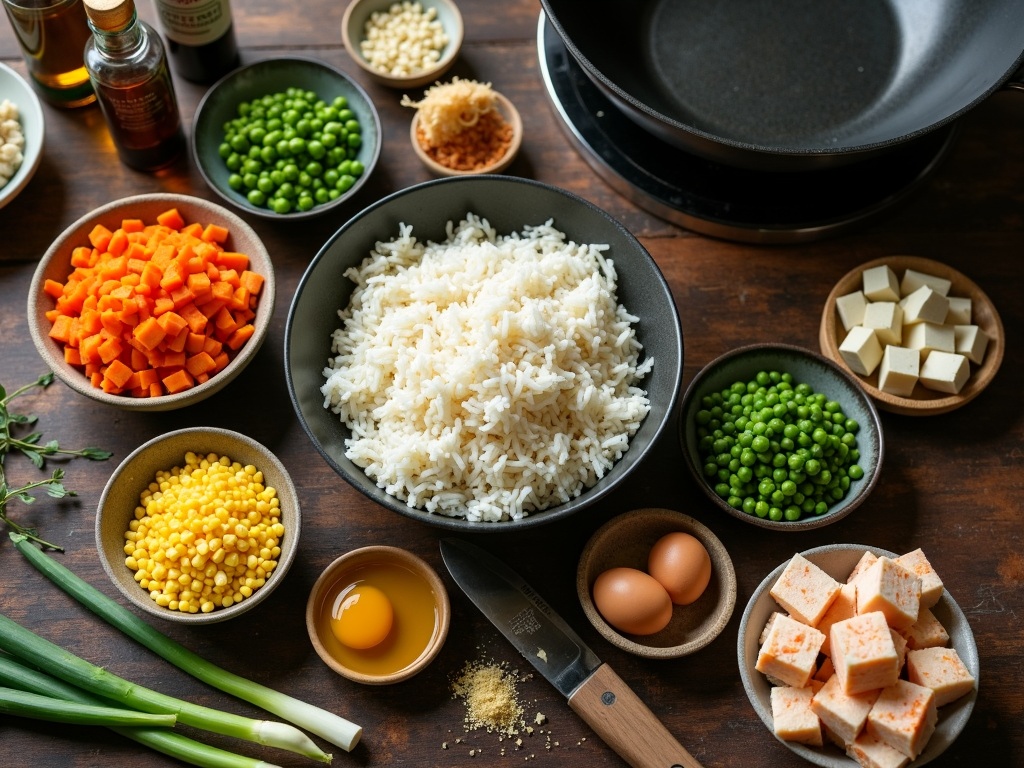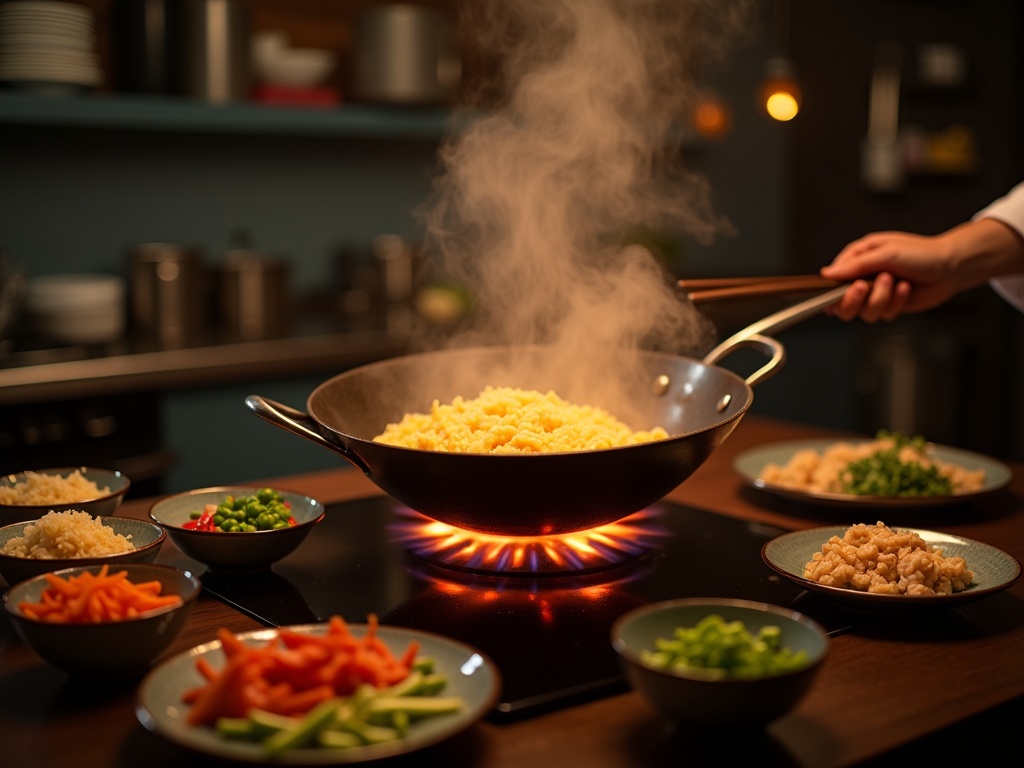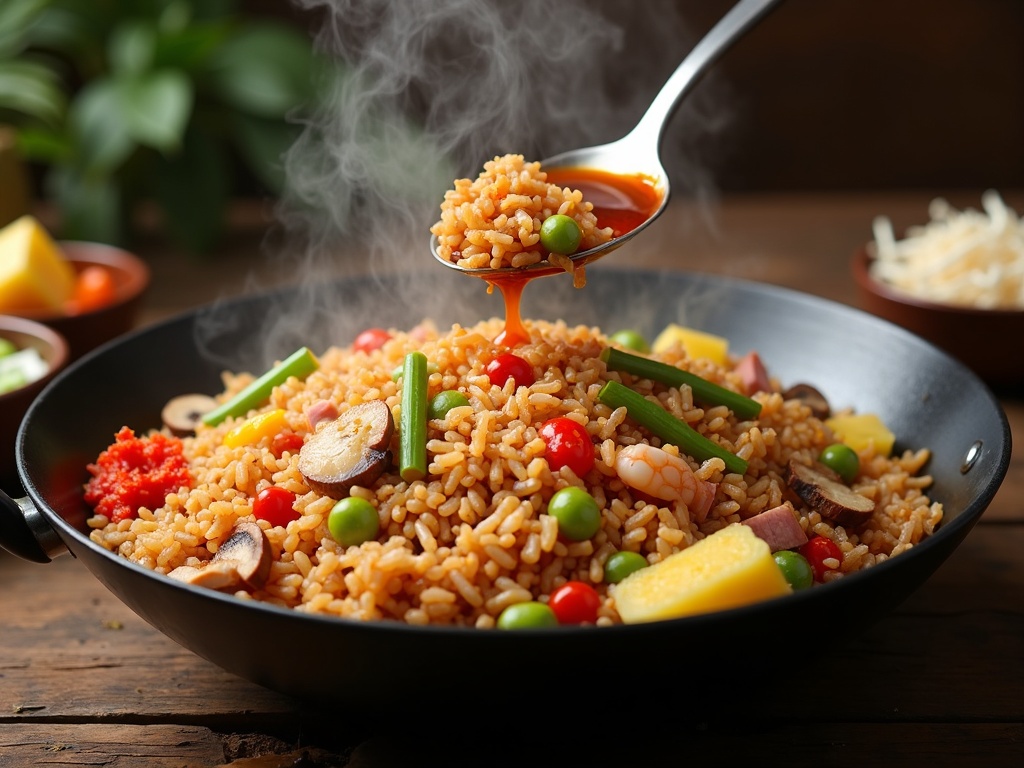Chinese fried rice delivers versatility with its distinct texture and flavor that comes from day-old rice and exact cooking methods. The high-heat stir-frying creates that signature “wok hei” flavor while maintaining crisp ingredients and separate rice grains.
Find In This Article
Key Takeaways
- Use cold, leftover rice rather than freshly cooked rice to prevent sogginess and achieve proper grain separation.
- Cook with high heat and keep ingredients in constant motion to create the authentic “wok hei” flavor profile.
- Prepare all ingredients before heating your wok, as the actual cooking process happens quickly.
- Season ingredients in layers throughout the cooking process rather than all at once for deeper flavor.
- Customize your fried rice with different proteins, vegetables, and seasonings to create countless variations.
Cooking Technique and Preparation
I find that the secret to perfect fried rice lies in both your ingredients and technique. Cold rice works best because its starches firm up overnight, letting each grain stay separate during cooking. I always dice my vegetables uniformly and cut proteins into bite-sized pieces for even cooking.
Wok Preparation and Cooking Order
My approach involves heating the wok until it smokes slightly before adding oil. This prevents ingredients from sticking and helps create that coveted smoky flavor. I add ingredients in specific order—aromatics first, then proteins, followed by vegetables and rice—each getting just enough time to cook without becoming mushy.
Must-Have Ingredients for Perfect Fried Rice
Making delicious Chinese fried rice at home relies on having the right ingredients ready before you start cooking. I’ve found that proper preparation makes all the difference between mediocre and restaurant-quality fried rice. Let me walk you through the essential components you’ll need.
The Foundation Elements
Day-old white rice serves as the perfect base for fried rice. Fresh rice contains too much moisture and will likely turn mushy when stir-fried. Cold rice that’s been refrigerated overnight allows the grains to dry out and firm up, creating that distinct separate-grain texture that’s characteristic of great fried rice.
Eggs add richness and protein to your dish. I like to scramble them separately first, then incorporate them back into the rice toward the end of cooking. This technique ensures the eggs maintain their texture rather than coating all the rice grains.
No fried rice is complete without a colorful mix of vegetables. The classic combination includes:
- Diced carrots for sweetness and color
- Green peas for a pop of freshness
- Corn kernels for added texture and sweetness
- Finely chopped green onions (both white and green parts)
The aromatics make all the difference in authentic Chinese fried rice. Minced garlic and grated ginger create that unmistakable fragrant base that elevates your dish from basic to spectacular. I typically use about one tablespoon of each for a family-sized portion.
For the seasonings and oils, you’ll need:
- Light soy sauce (adds saltiness and umami without darkening the rice too much)
- Sesame oil (just a teaspoon at the end provides incredible aroma)
- Cooking oil with a high smoke point like vegetable, canola, or peanut oil
Adding protein transforms fried rice from a side dish to a complete meal. Popular options include:
- Diced chicken
- Peeled shrimp
- Cubed firm tofu
For meat options, I recommend cooking them separately first before adding to the rice to ensure they’re properly cooked through.
The beauty of fried rice is its versatility — you can customize it based on what’s in your refrigerator. I often make a basic vegetable version as a side dish, but when I want something more substantial, I’ll add leftover roast pork or beef. If you love beef in your Chinese dishes, you might also enjoy my beef chow mein recipe which uses similar cooking techniques.
The key to perfect fried rice isn’t just having all these ingredients on hand, but also in the preparation. I always chop and organize everything before heating my wok or skillet. This mise en place approach means once the high-heat cooking begins, I can focus entirely on the quick movements needed for perfect stir-frying.
For the best results, each component should be roughly the same size—small dice or minced—so everything cooks evenly. The vegetables should be fresh or properly thawed if frozen, and the rice should be broken up by hand before adding it to the pan to eliminate any clumps.
With these key ingredients ready to go, you’re well on your way to creating authentic Chinese fried rice that rivals your favorite restaurant’s version.

Step-by-Step Cooking Method
Preparing the Wok and Initial Ingredients
I start by heating my wok or large skillet over high heat until it’s smoking hot. This intense heat is crucial for authentic Chinese fried rice as it prevents sticking and creates that distinctive “wok hei” flavor.
While the wok is heating, I quickly beat a couple of eggs in a small bowl. Once the wok is ready, I add a small amount of oil, swirling to coat the surface. Next, I pour in the beaten eggs, allowing them to spread thinly. As they start to set, I gently scramble them until just cooked through but still tender. Then I transfer them to a plate for later use.
With the eggs set aside, I add a bit more oil to the wok and toss in minced garlic and grated ginger. I stir continuously for about 30 seconds until fragrant but not burned – this happens quickly at high heat!
If I’m adding protein to my Chinese fried rice like chicken, beef, or shrimp, I add it now, cooking it thoroughly before moving to the next step.
Completing the Dish
Once my protein is cooked, I add diced vegetables like carrots, peas, bell peppers, or corn. I stir-fry them quickly, keeping them tender-crisp for a perfect texture contrast in the final dish.
The star of the show now enters – cold, leftover rice! I add it to the wok and break up any clumps with my spatula. Cold rice works best because fresh rice often becomes soggy. I stir-fry for 2-3 minutes, tossing continuously to heat it through.
Now for the flavor boost: I drizzle soy sauce and sesame oil around the edges of the wok, letting them sizzle before mixing through the rice. This technique infuses maximum flavor into each grain.
As a final step, I fold in the scrambled eggs and sliced green onions, tossing everything together just until heated through. The entire cooking process takes less than 10 minutes once all ingredients are prepped.
The key points to remember for perfect fried rice include:
- Use day-old cold rice for best texture
- Keep your wok extremely hot throughout cooking
- Prep all ingredients before starting
- Cook ingredients in the right order
- Keep everything moving in the wok
- Season at the end to prevent sogginess

Common Mistakes to Watch Out For
When making Chinese fried rice at home, I’ve noticed several pitfalls that can turn this seemingly simple dish into a disappointing meal. Identifying these common errors will help you create that authentic restaurant-quality fried rice you’re craving.
Recipe Pitfalls to Avoid
- Using freshly cooked rice is one of the biggest mistakes in fried rice preparation. Fresh rice contains too much moisture, resulting in a soggy, clumpy final dish. Instead, use day-old refrigerated rice that has had time to dry out. This creates the separate, firm grains essential for good fried rice. If you’re in a hurry, spread freshly cooked rice on a baking sheet and let it cool completely before using.
- Not having ingredients prepared beforehand can derail your cooking process. Fried rice cooks quickly, giving you little time to chop or measure once you’ve started. I always recommend setting up a mise en place (everything in place) before heating your wok or pan.
- Cooking with low heat is a common error that prevents that coveted wok hei flavor. High heat is crucial for properly searing the ingredients and creating those delicious crispy bits. Your pan should be hot enough that ingredients sizzle immediately upon contact.
- Overcrowding the pan prevents proper heat distribution and causes ingredients to steam rather than fry. If cooking a large batch, work in portions to maintain the high heat needed for authentic texture. This is especially important when making other Chinese dishes like beef chow mein, where texture is equally important.
- Adding too much soy sauce is tempting but can overwhelm other flavors and make your rice too wet and dark. I suggest starting with just a tablespoon or two, then adjusting to taste. Remember that many other ingredients in fried rice—like eggs, vegetables, and meat—contribute their own natural flavors.
By avoiding these common mistakes, your homemade Chinese fried rice will rival any restaurant version, with perfectly separated grains and balanced flavor in every bite.
Secret Tips for Restaurant-Quality Results
Making Chinese fried rice at home that rivals your favorite restaurant isn’t as complicated as it might seem. I’ve spent years perfecting this popular dish, and I’m happy to share some insider secrets that will transform your homemade version into something truly special.
Start With the Right Rice
Cold, leftover rice is absolutely essential for authentic Chinese fried rice. Fresh rice contains too much moisture and will turn mushy when stir-fried. I always cook rice a day ahead and store it in the refrigerator overnight. This allows the grains to dry out and firm up, creating that distinct chewy texture that makes restaurant fried rice so satisfying.
Before adding rice to your wok, take time to break up any clumps with your fingers. Large chunks of rice won’t cook evenly and can ruin the texture of your final dish. I gently press and separate the cold rice in a bowl to ensure each grain remains individual when cooking.
Some quick tips for rice preparation:
- Use medium to long-grain rice for best results
- Cook rice with slightly less water than normal for firmer grains
- Spread freshly cooked rice on a baking sheet to cool quickly before refrigerating
- Allow at least 4 hours of refrigeration, but overnight is best
Master the Wok Technique
Temperature control makes or breaks your fried rice. I always preheat my wok until it’s smoking hot before adding any ingredients. This high heat creates that distinctive “wok hei” flavor—the slightly smoky, charred taste that’s characteristic of restaurant-quality Chinese food.
Once your wok is properly heated, add a high smoke-point oil like peanut or avocado oil. The ingredients should sizzle dramatically when they hit the surface. This initial sear is crucial for locking in flavors and preventing sogginess.
Constant motion is another professional secret. I never stop moving the ingredients around in the wok—tossing, turning, and stirring continuously. This ensures everything cooks evenly without burning. If you’re new to wok cooking, try the push-pull technique: push ingredients up the sides of the wok, then pull them back down through the center.
Perfect Your Seasoning Approach
Restaurant chefs never dump all seasonings in at once. I add salt, soy sauce, and other flavorings gradually throughout the cooking process. This layered approach builds depth that can’t be achieved with last-minute seasoning.
Start by seasoning your proteins, then vegetables, and finally the rice itself. Between each addition, taste and adjust. I find that many home cooks under-season their fried rice, afraid of adding too much salt or soy sauce. Don’t be timid with seasonings—proper fried rice should have a bold flavor profile.
For truly authentic flavor, consider adding these traditional ingredients:
- A small drizzle of toasted sesame oil at the finish
- White pepper instead of black pepper
- A pinch of MSG (yes, it’s what many restaurants use!)
- Chinese cooking wine (Shaoxing) for depth
The same attention to detail applies when making other Chinese classics like beef chow mein or stir-fries.
Remember that cooking great fried rice takes practice. Each time you make it, you’ll develop a better feel for the right heat, timing, and seasoning. Soon enough, friends and family will be asking for your secret to making Chinese fried rice that’s even better than takeout.
Storage and Serving Suggestions
Chinese fried rice makes fantastic leftovers. The flavors actually develop further as they sit, creating an even more delicious meal the next day. I’ve found a few simple techniques that ensure your fried rice remains just as tasty when stored and reheated.
Proper Storage Methods
After cooling your fried rice completely, always transfer it to an airtight container before refrigerating. This crucial step prevents the rice from absorbing other odors in your refrigerator and helps maintain its moisture level. Properly stored Chinese fried rice stays good in the refrigerator for up to 3 days, though I’ve found it’s at its best within the first 2 days.
If you’ve made a large batch, consider dividing it into smaller portions before storing. This approach makes reheating more convenient and prevents you from repeatedly warming the entire batch, which can dry out the rice.
For longer storage, you can freeze fried rice in freezer-safe containers or heavy-duty freezer bags. When properly sealed, frozen fried rice maintains quality for up to 2 months. Just be sure to label each container with the date so you can keep track.
Reheating Techniques
The way you reheat your fried rice significantly impacts its texture and flavor. I recommend these methods:
- Microwave method: Place a portion in a microwave-safe dish, sprinkle 1–2 teaspoons of water over the rice, cover loosely, and heat on medium power in 30-second intervals, stirring between each until hot throughout.
- Skillet method: Heat a tablespoon of oil in a skillet over medium-high heat, add the cold rice, and stir-fry for 3–4 minutes until heated through and slightly crispy again.
- Oven method: Spread rice on a baking sheet, cover with foil, and heat at 350°F for about 10 minutes.
The skillet method is my favorite as it revives some of the original texture and prevents the rice from becoming mushy. It’s particularly effective for bringing back that restaurant-quality taste to dishes like beef chow mein or other Chinese favorites.
When reheating, you might notice the rice has dried out slightly. Don’t worry – this is normal and easily fixed by adding a small amount of water or additional soy sauce during the reheating process.
The finishing touches make all the difference when serving reheated fried rice. I always offer additional soy sauce on the side so everyone can adjust the saltiness to their preference. A small dish of chili oil or sriracha also gives diners options to spice up their portions.
For presentation, garnish with freshly chopped green onions just before serving to add color, freshness, and a subtle bite that complements the savory rice perfectly. This simple step instantly refreshes the dish and makes it look freshly made.
If you’re serving the rice as a main course, consider adding a fried egg on top – the runny yolk creates a rich sauce that elevates the entire dish. For a complete meal, pair with fresh cucumber salad or steamed vegetables to balance the flavors.
Customize Your Fried Rice
Chinese fried rice serves as a perfect canvas for culinary creativity. I’ve discovered that the beauty of this dish lies in its versatility, allowing for countless variations with just a few ingredient swaps.
Protein and Flavor Variations
Adding different proteins transforms basic fried rice into a substantial meal. Leftover roast chicken shredded into small pieces brings a subtle savory note, while diced ham adds a salty dimension. For seafood lovers, small cooked shrimp or flaked crabmeat creates a deluxe version worth trying.
For a Korean-inspired twist, mix in some kimchi. The fermented vegetables add a spicy, tangy element that cuts through the richness of the rice. Don’t go overboard – start with about a quarter cup for a standard batch and adjust to your taste preference.
Thai-style fried rice benefits from the addition of fresh pineapple chunks. The sweet, acidic fruit creates a pleasant contrast with savory soy sauce and proteins. This combination works particularly well with shrimp or chicken.
For serious flavor enthusiasts, a spoonful of XO sauce takes fried rice to new heights. This premium seafood-based condiment packs incredible umami depth that elevates even the simplest version of the dish.
The vegetable possibilities are nearly endless when customizing fried rice:
- Diced bell peppers add color and sweetness
- Snap peas provide fresh crunch
- Shredded cabbage incorporates subtle texture
- Bean sprouts bring lightness to balance heavier ingredients
- Sliced mushrooms create earthiness and meaty texture
For best results, I cut all vegetables into similar-sized small pieces to cook evenly and distribute throughout the dish. If you’re looking for more complete Chinese meal ideas to pair with your fried rice, my beef chow mein recipe makes an excellent companion dish.
Don’t be afraid to combine elements from different variations. A kimchi fried rice with mushrooms and shrimp creates a fusion that might become your new favorite. The key is maintaining the proper rice-to-ingredient ratio so the dish doesn’t become overcrowded and difficult to stir-fry properly.


